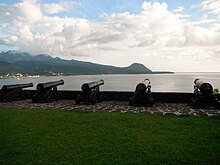| Fort Shirley | |
|---|---|
| Cabrits National Park, Dominica | |
 Mountain top view of Fort Shirley | |
| Coordinates | 15°35′00″N 61°28′25″W / 15.5834°N 61.4735°W |
| Type | Fortification |
| Site history | |
| Built | 1765 |
| In use | No |
| Materials | Stone and brick |
Fort Shirley is a historic military outpost on the Caribbean island of Dominica. It was built by the British in 1765, and was named for Sir Thomas Shirley. [1] The fort was the location of the 1802 revolt of the 8th West India Regiment. [2] Today, Fort Shirley is part of Cabrits National Park, which was established as a national park in 1986. [2] [3]

Location
Fort Shirley is located on a peninsula just north of Portsmouth, in an area known as Prince Rupert's Head. [4] [5] The fort overlooks two bays: Prince Rupert's Bay and Douglas Bay. [2]
History
The British began Fort Shirley's construction in 1765 as a garrison to defend north Dominica. [2] The fort was named for Sir Thomas Shirley, Governor of the Leeward Islands at the time. [1] From 1778 to 1784, the fort was extended by the French during their occupation of Dominica. [2] The fort was built of brick and stone in the Georgian architectural style. It consisted of more than 50 buildings, [6] [2] including seven gun batteries, seven cisterns, powder magazines, and ordnance storehouses, as well as barracks that could house over 600 men. [6] [2] [7]
In April 1802, the revolt of the 8th West India Regiment took place at Fort Shirley. [8] [9] African soldiers, who were recruited as slaves and stationed at Fort Shirley, mutinied and took over the garrison for three days. [2] They did so in protest of poor conditions, lack of pay, and fears of being sold back into slavery. [10] [2] The revolt influenced the Mutiny Act 1807, [2] [11] under which all serving soldiers recruited as slaves in the West India Regiments of the British Army were freed. [12]
By the 1850s, the fort had fallen out of use. It was abandoned in 1854, [6] [13] but remained in the hands of the British Admiralty. [2] In 1901, the fort's ownership was transferred to the government of the Dominica and it remained designated as Crown Land. [2] The fort and the land around were sometimes used as a quarantine station and agricultural station, [14] [2] as well as an experimental teak forestry project. [14]


Restoration
After years of deterioration, Dr. Lennox Honychurch began restoration of the fort's structures in 1982. [2] [15] Several of the buildings have been completely restored, while ruins of the rest can be found scattered around the peninsula. [15] [16]
References
- ^ a b Philpott, Don (1999). Antigua and Barbuda. Hunter Publishing, Inc. ISBN 978-1-901522-02-0.
- ^ a b c d e f g h i j k l m n "Fort Shirley". UNESCO World Heritage Centre. Retrieved 2023-09-23.
- ^ "Laws of Dominica: National Parks and Protected Areas Act, 1975". FAOLEX Database: Food and Agriculture Organization of the United Nations. 1975. Retrieved 2023-09-25.
- ^ Marshall, Lydia Wilson (2015). The Archaeology of Slavery: A Comparative Approach to Captivity and Coercion. SIU Press. ISBN 978-0-8093-3397-4.
- ^ DeCorse, Christopher R.; Beier, Zachary J. M. (2018-03-14). British Forts and Their Communities: Archaeological and Historical Perspectives. University Press of Florida. ISBN 978-0-8130-5223-6.
- ^ a b c "Cabrits National Park". national-parks.org. Global Alliance of National Parks. Retrieved 2023-09-23.
- ^ Christian, Gabriel J. (2013-11-03). "Emancipation, Independence and the Resurrection of Dominica's Fort Shirley". Dominica News Online. Retrieved 2023-09-25.
- ^ Iverson, Justin (2022-11-01). Rebels in Arms: Black Resistance and the Fight for Freedom in the Anglo-Atlantic. University of Georgia Press. ISBN 978-0-8203-6278-6.
- ^ Hart, Richard (1998). From Occupation to Independence: A Short History of the Peoples of the English-speaking Caribbean Region. Pluto Press. ISBN 978-0-7453-1382-5.
- ^ Lockley, Tim (November 16, 2017). "Mutiny! The story of the 8th West India Regiment". British Library.
- ^ Beier, Zachary (2017-06-30). "All the King's Men: Slavery and Soldiering at the Cabrits Garrison (1763-1854)". Dissertations - Syracuse University.
- ^ "Slavery reparations: An historian's view". www.bbc.co.uk. BBC Caribbean. Retrieved 2023-09-24.
- ^ Myers, Robert A. (1987). A Resource Guide to Dominica, 1493-1986. Human Relations Area Files.
- ^ a b Dominica. The Caribbean Conservation Association. 1991.
- ^ a b "Years of Investment in Fort Shirley Paying Off". news.gov.dm. January 28, 2021. Retrieved 2023-09-23.
- ^ Byron, Anglina (2023-05-21). "Dominica: How Fort Shirley in Cabrits National Park offers extensive experience". Associates Times a Caribbean News website. Retrieved 2023-09-23.

